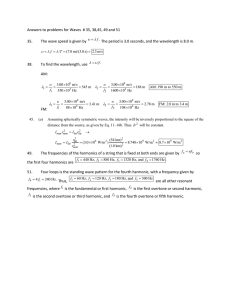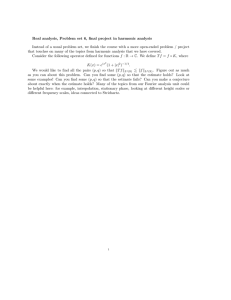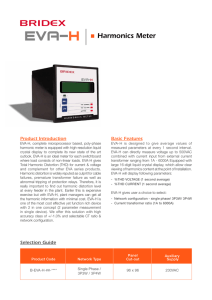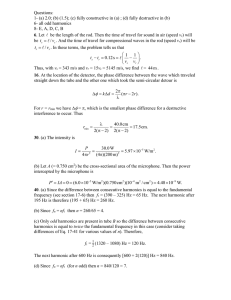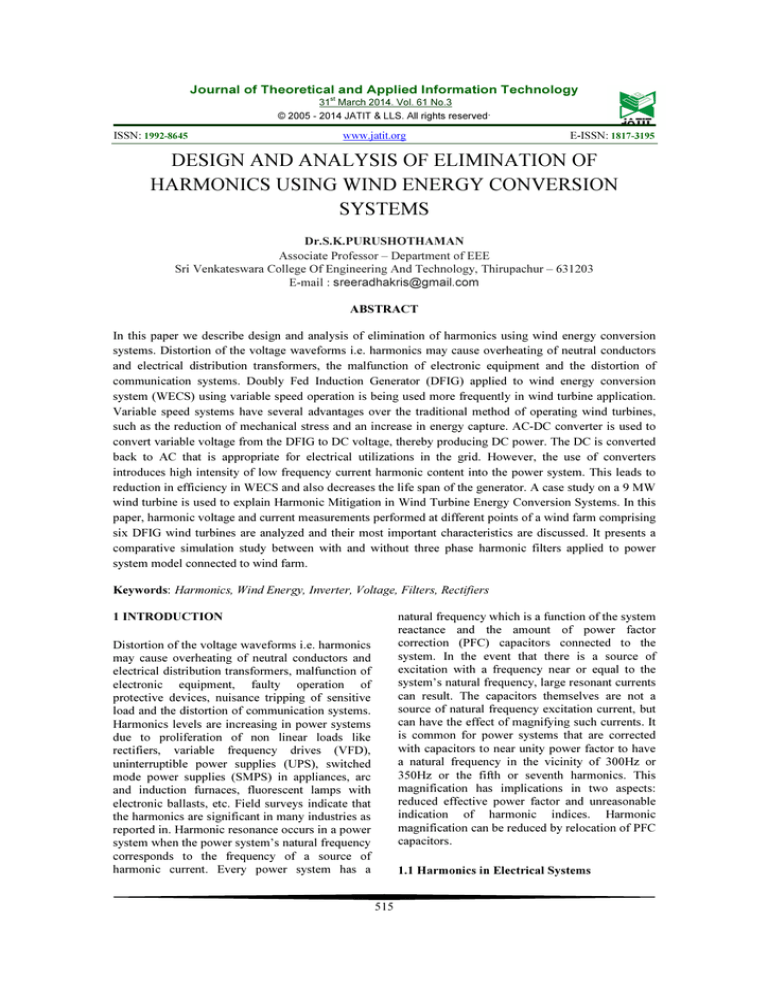
Journal of Theoretical and Applied Information Technology
31st March 2014. Vol. 61 No.3
© 2005 - 2014 JATIT & LLS. All rights reserved.
ISSN: 1992-8645
www.jatit.org
E-ISSN: 1817-3195
DESIGN AND ANALYSIS OF ELIMINATION OF
HARMONICS USING WIND ENERGY CONVERSION
SYSTEMS
Dr.S.K.PURUSHOTHAMAN
Associate Professor – Department of EEE
Sri Venkateswara College Of Engineering And Technology, Thirupachur – 631203
E-mail : sreeradhakris@gmail.com
ABSTRACT
In this paper we describe design and analysis of elimination of harmonics using wind energy conversion
systems. Distortion of the voltage waveforms i.e. harmonics may cause overheating of neutral conductors
and electrical distribution transformers, the malfunction of electronic equipment and the distortion of
communication systems. Doubly Fed Induction Generator (DFIG) applied to wind energy conversion
system (WECS) using variable speed operation is being used more frequently in wind turbine application.
Variable speed systems have several advantages over the traditional method of operating wind turbines,
such as the reduction of mechanical stress and an increase in energy capture. AC-DC converter is used to
convert variable voltage from the DFIG to DC voltage, thereby producing DC power. The DC is converted
back to AC that is appropriate for electrical utilizations in the grid. However, the use of converters
introduces high intensity of low frequency current harmonic content into the power system. This leads to
reduction in efficiency in WECS and also decreases the life span of the generator. A case study on a 9 MW
wind turbine is used to explain Harmonic Mitigation in Wind Turbine Energy Conversion Systems. In this
paper, harmonic voltage and current measurements performed at different points of a wind farm comprising
six DFIG wind turbines are analyzed and their most important characteristics are discussed. It presents a
comparative simulation study between with and without three phase harmonic filters applied to power
system model connected to wind farm.
Keywords: Harmonics, Wind Energy, Inverter, Voltage, Filters, Rectifiers
natural frequency which is a function of the system
reactance and the amount of power factor
correction (PFC) capacitors connected to the
system. In the event that there is a source of
excitation with a frequency near or equal to the
system’s natural frequency, large resonant currents
can result. The capacitors themselves are not a
source of natural frequency excitation current, but
can have the effect of magnifying such currents. It
is common for power systems that are corrected
with capacitors to near unity power factor to have
a natural frequency in the vicinity of 300Hz or
350Hz or the fifth or seventh harmonics. This
magnification has implications in two aspects:
reduced effective power factor and unreasonable
indication of harmonic indices. Harmonic
magnification can be reduced by relocation of PFC
capacitors.
1 INTRODUCTION
Distortion of the voltage waveforms i.e. harmonics
may cause overheating of neutral conductors and
electrical distribution transformers, malfunction of
electronic equipment, faulty operation of
protective devices, nuisance tripping of sensitive
load and the distortion of communication systems.
Harmonics levels are increasing in power systems
due to proliferation of non linear loads like
rectifiers, variable frequency drives (VFD),
uninterruptible power supplies (UPS), switched
mode power supplies (SMPS) in appliances, arc
and induction furnaces, fluorescent lamps with
electronic ballasts, etc. Field surveys indicate that
the harmonics are significant in many industries as
reported in. Harmonic resonance occurs in a power
system when the power system’s natural frequency
corresponds to the frequency of a source of
harmonic current. Every power system has a
1.1 Harmonics in Electrical Systems
515
Journal of Theoretical and Applied Information Technology
31st March 2014. Vol. 61 No.3
© 2005 - 2014 JATIT & LLS. All rights reserved.
ISSN: 1992-8645
www.jatit.org
E-ISSN: 1817-3195
loads, nuisance breaker tripping, incorrect meter
functioning, failure of protection relays, increased
system losses as heat, etc.
One of the biggest problems in power quality
aspects is the harmonic contents in the electrical
system. Generally, harmonics may be divided into
two types: 1) voltage harmonics, and 2) current
harmonics. Current harmonics is usually generated
by harmonics contained in voltage supply and
depends on the type of load such as resistive load,
capacitive load, and inductive load. Both
harmonics can be generated by either the source or
the load side. Harmonics generated by load are
caused by nonlinear operation of devices,
including power converters, arc-furnaces, gas
discharge lighting devices, etc. Load harmonics
can cause the overheating of the magnetic cores of
transformer and motors. On the other hand, source
harmonics are mainly generated by power supply
with non-sinusoidal voltage waveform. Voltage
and current source harmonics imply power losses,
Electromagnetic Interference (EMI) and pulsating
torque in AC motor drives. Any periodic
waveform can be shown to be the superposition of
a fundamental and a set of harmonic components.
By applying Fourier transformation, these
components can be extracted. The frequency of
each harmonic component is an integral multiple
of its fundamental. There are several methods to
indicate of the quantity of harmonics contents. The
most widely used measure in North America is the
total harmonics distortion (THD), which is defined
in terms of the amplitudes of the harmonics, Hn, at
frequency nW0, where Wo is frequency of the
fundamental component whose amplitude of H1
and n is integer. The THD is mathematically given
by
2 STANDARDS FOR HARMONICS
Harmonic voltages have to be kept within
acceptable limits; the limits depend on network
specification, such as harmonic impedance and
voltage level. IEC 61000-3-6 can be used as a
guide to find these limits. Table 1 shows indicative
planning levels for the normal harmonics in a
power grid and the ones considered in this paper,
planning levels are equal to or lower than
compatibility levels. The indicative planning levels
for the total harmonic distortion for MV are
THDMV=6.5%.
Table 1: Indicative planning levels for harmonic
voltages (in percent of the fundamental voltage)
for medium level voltages (<35 kV)
Harmonic order h
Harmonic voltage %
5
7
5
4
11
13
3
2.5
3 NEED FOR HARMONIC REDUCTION
Resonance is the point where the inductive
impedance of the connected object equals the
capacitive impedance of the capacitors at a given
frequency. The typical scenario in a grid is that
resonance is most significant at the 3rd, 5th and
7th harmonic. Although the voltages are low at
these harmonics the very small resistances can
cause destructive currents. Figure 1 shows a
nonlinear load supplied by a voltage source ES.
The voltage source has an impedance XS and is
connected to a transformer with leakage reactance
XT. The load is equipped with a capacitor bank
XC.
1.2 Harmonics ILL Effects
Harmonics produce many ill effects such as: very
high neutral currents in 3P-4W system, high
neutral to ground voltages, over heating of neutral
conductor, reduced power factor, failure of PFC
capacitors,
overloading
of
distribution
transformers, distorted voltage waveforms to other
516
Journal of Theoretical and Applied Information Technology
31st March 2014. Vol. 61 No.3
© 2005 - 2014 JATIT & LLS. All rights reserved.
ISSN: 1992-8645
www.jatit.org
E-ISSN: 1817-3195
4 WIND TURBINE MODEL
The wind turbine consists of a rotor that extracts
energy from the wind and converts it into
mechanical power. In practice, the characteristics
of a wind turbine can be represented in a
simplified form of power performance coefficient
(Cp ) and tip speed ratio (λ ). The Cp –λ curve is
usually used in industry to describe the
characteristics of a wind turbine. The tip speed
ratio of a wind turbine is given by:
Fig 1 : Voltage Source And Transformer Connected To
Nonlinear Load
The value of the harmonic inductive reactance
XLH increases in proportion with harmonic order,
while the harmonic reactance XCH of the
capacitor bank decreases inversely with the
harmonic order. Perfect resonance occurs at XLH
= XCH but even partial resonance XLH ≈ XCH
can have important effects. Table 2 shows several
XCH/XLH ratios in the vicinity of resonance and
corresponding IC/IH and IL/IH multipliers,
illustrating the danger of overheating the capacitor
and primary and secondary windings of the
transformer, and ultimately the importance of
controlling and reducing the harmonics.
Where:
R - the turbine rotor radius in meters (m);
ωr - turbine rotor speed in radians per second
(rad/s);
V - the wind speed in meters per second (m/s).
5 POWR SYSTEM MODEL - WIND FARM
USING DFIG
The WECS considered for analysis consist of a
DFIG driven by a wind turbine, rotor side
converter, DC to DC intermediate circuit and grid
side converter. Fig.2 shows a schematic of the
wind energy conversion system having DFIG and
power electronic interface that will be discussed in
this paper. The turbine output power is controlled
in order to follow a pre-defined power-speed
characteristic, named tracking characteristic. The
electrical output power at the grid terminals of the
wind turbine is added to the power losses and is
compared with the reference power obtained from
the tracking characteristic.
Table 2: Amplification Of Current IH
XCH/XLH
IC/IH I
IL/IH
0.7
0.9
1
1.1
1.3
3.33
10
>20
10
3.33
2.33
9
>20
11
4.33
517
Journal of Theoretical and Applied Information Technology
31st March 2014. Vol. 61 No.3
© 2005 - 2014 JATIT & LLS. All rights reserved.
ISSN: 1992-8645
www.jatit.org
E-ISSN: 1817-3195
Fig.2 Power System Model
In rotor side converter system, AC voltage and
VAR are regulated. DC to DC intermediate circuit
consists of two converters: Converter 1 (DC to
AC) and Converter 2 (AC to DC). The control
system of DC to DC intermediate circuit consists
of DC voltage and current regulation and pitch
control system. The pitch angle is regulated at zero
degree by pitch angle regulator until the speed
reaches desired speed of the tracking
characteristic. The DC voltage output from
intermediate circuit is applied to grid side
converter, which consists of an Insulated Gate
Bipolar Transistor (IGBT) two-level inverter,
generating AC voltage at 50 Hz. The IGBT
inverter uses Pulse Width Modulation (PWM) at
2000 Hz carrier frequency. A 9 MW wind farm
518
Journal of Theoretical and Applied Information Technology
31st March 2014. Vol. 61 No.3
© 2005 - 2014 JATIT & LLS. All rights reserved.
ISSN: 1992-8645
www.jatit.org
consisting of six 1.5 MW wind turbines connected
to 440V distribution system through power
electronic interface. The wind speed is maintained
constant at 15 m/s. The reactive power produced
by the wind turbine is regulated at 0 MVAR. This
model is well suited for observing harmonics and
control system dynamic performance over
relatively short periods of times. Fig.2 shows
power system model used. The harmonic filters are
connected to buses B1 to B4 as shown in Fig.2.
E-ISSN: 1817-3195
other harmonic filters i.e. 24th to B3 and 1st,
11th/13th and 24th to B4 distort the results or
harmonic distortion is increased.
6 HARMONIC MITIGATION BY
HARMONIC FILTERS
Harmonic filters reduce distortion by diverting
harmonic currents in low impedance paths. In
order to achieve an acceptable distortion, several
banks of filters of different types are usually
connected in parallel. The total harmonic
distortion (THD) can be calculated as follows:
Fig.3 Three Phase Harmonic Filters
7 RESULTS AND DISCUSSIONS
In this section the simulated results for the grid
connection of three phase harmonic filters
described above are presented. Two cases are
considered to investigate the impact of harmonic
filters on power grid connected with wind energy.
One case (Case 1) is that harmonic filters are not
connected to power grid and another case (Case 2)
is taken as harmonic filters connected to AC power
grid.
The comparison of magnitude of voltage THD
having range 0-1 is presented in Fig.5-Fig.8. Table
3 shows the effect of adding harmonic filters in
terms of voltage THDs in the existing integrated
wind energy power system model. The %reduction
in peak value of voltage THD with harmonic
filters at busbar locations B1, B2, B3 and B4 are
80%, 80.36%, 90% and -0.8% respectively. Thus
reduction in THD is significant at B1, B2 and B3.
Although peak value of voltage THD rises at B4,
but it is clear from Fig.8 that values of voltage
THD is less in Case 2 as compared to Case 1 at
other times. Table 4 presents the effect of adding
harmonic filters in terms of current THDs in the
existing integrated wind energy power system
model. The %reduction in peak value of current
THD with harmonic filters at busbar locations B1,
B2, B3 and B4 are 76.5%, 35.5%. 28.6% and
95.7% respectively. The peak value at B4 with
harmonic filters increase or % reduction is - 0.8%
because as we keep on adding harmonic filters in
One Double-Tuned Filter to 11/13th harmonic of
100 MVAR and -One High-Pass Filter Tuned to
the 24th harmonic of 100 MVAR The total MVAR
rating of the filters set is then 400 MVAR. Fig.3
shows three phase harmonic filters connected to
grid, which are used to improve power quality and
reduce harmonic distortion. The entire harmonic
filter set, 1st, 3rd, 11th/13th and 24th, are
connected to bus B1 and B2. Harmonic filters 1st,
3rd and 11th/13th are connected to B3. Only
harmonic filter 3rd is connected to B4. This is
done because it is observed that connection of
519
Journal of Theoretical and Applied Information Technology
31st March 2014. Vol. 61 No.3
© 2005 - 2014 JATIT & LLS. All rights reserved.
ISSN: 1992-8645
www.jatit.org
power system starting from lowest voltage, a stage
will come when it will cause increase in harmonic
E-ISSN: 1817-3195
level.
Table3: Effect Of Adding Harmonic Filters In Terms Of Voltage Thds
Busbar Location /
Voltage THD
B1
B2
B3
B4
Peak Value Without
Harmonic Filters
0.8
0.82
1.5
0.253
Peak Value With
Harmonic Filters
0.16
0.161
0.15
0.255
% Reduction
80%
80.36%
90%
-0.8%
Table 4: Effect Of Adding Harmonic Filters In Terms Of Current Thds
Busbar Location/
Current THD
B1
B2
B3
B4
Peak Value Without
Harmonic Filters
0.98
0.4
0.7
3.5
Peak Value With
Harmonic Filters
0.23
0.258
0.5
0.15
Fig. 5. Comparison Of Voltage THD At Bus B1
Fig. 6. Comparison Of Voltage THD At Bus B2
520
% Reduction
76.5%
35.5%
28.6%
95.7%
Journal of Theoretical and Applied Information Technology
31st March 2014. Vol. 61 No.3
© 2005 - 2014 JATIT & LLS. All rights reserved.
ISSN: 1992-8645
www.jatit.org
E-ISSN: 1817-3195
Fig. 7. Comparison of Voltage THD at Bus B3
Fig. 8. Comparison of Voltage THD at Bus B4
inclusion of harmonic filters THD reduces
noticeably and hence power quality improves
significantly. Wind turbines in the model base on
the topology of the induction generator with backto-back converters. The model comprises the wind
farm from the DC-link of the wind turbine
converters to the 132 kV transmission grid.
Demonstrations are done showing that the model
functions as required, regulating itself at the
respective set points. The model is also proven to
work in different park configuration. The model is
used for experimenting for the development of a
method that can reduce voltage harmonics in a
wind farms internal electrical network using the
wind turbine inverters. The development was
successful and a method is produced. Basing on
the theory behind series active filters the inverter
control circuit is modified, by adding an additional
8. CONCLUSION AND FUTURE WORK
Harmonics analysis is an essential part of the grid
impact studies needed for new wind farms. That
can lead to the earlier detection of potential series
and parallel resonance problems. Consequently, a
harmonics mitigation solution is examined in this
paper. The simulated results on transients of a
power system grid integrated with wind power are
presented. In this paper, we attempted to compare
the impact, in terms of voltage THDs and currents
THDs, of adding three phase harmonic filters to
wind integrated power system consisting of DFIG.
Two different cases are considered examining the
influence of adding harmonic filters. The results
have clearly demonstrated the ability of harmonic
filters to reduce transients and harmonic distortion
in power system. It has been proven that with the
521
Journal of Theoretical and Applied Information Technology
31st March 2014. Vol. 61 No.3
© 2005 - 2014 JATIT & LLS. All rights reserved.
ISSN: 1992-8645
www.jatit.org
E-ISSN: 1817-3195
[5] Larsson, A. (2005). Practical Experience with
Power Quality and Wind Power. In T.
Ackermann, Wind Power in Power Systems
(pp. 349-363). John Wiley & Sons, Ltd.
[6] H. M. Kojabadi, L. Chang, T. Boutot,
“Development of a novel wind turbine
simulator for wind energy conversion
systems
using
as
inverter-controlled
induction motor”, IEEE Transactions on
Energy Conversion, vol. 19, no. 3, pp. 547552, Sept.2004.
[7] L. Mihet-Popa, F. Blaabjerg, I. Boldea, “Wind
turbine generator modeling and simulation
where rotational speed is the controlled
variable”, IEEE Transactions on Industry
Applications, vol. 40, no. 1, pp. 3-10,
January/February 2004.
[8] Francis M. Fernandez, P. S.Chandramohanan
Nair,
.Influence
of
Power
Factor
Compensating Capacitors on Estimation of
Harmonic Distortion., 9th Int. conference on
Electrical Power quality and Utilisation,
Barcelona, 2007.
[9] Mark Mcgranaghan Scott Peele and Dan
Murray, .Solving Harmonic Resonance
Problems On The Medium Voltage System.,
CIRED, 19th International Conference on
Electricity Distribution, Vienna, 21-24 May
2007.
[10] Zhang, S Tseng, K Vilathgamuwa, M.
Nguyen, D.,” Design of a Robust Grid
Interface System for PMSG-based Wind
Turbine Generators”. In: IEEE Transactions
on Industrial Electronics, Issue 99, 2010.
[11] H. Akagi, "Active Harmonic Filter," In:
Proceedings of the IEEE, 2005, pp. 21282141.
[12] J. Arrillaga and N. R. Watson, Power System
Harmonics, 2nd ed. NJ:Wiley, 2003.
[13] R. S. Herrera, P. Salmeron, and H. Kim,
“Instantaneous Reactive Power Theory
Applied
to
Active
Power
Filter
Compensation:
Different
Approaches,
Assessment, and Experimental Results,” In:
IEEE Trans. Ind. Electron., Jan. 2008, Vol.
55, No. 1, pp. 184–196.
[14] J. Rodriguez, S. Bernet, B. Wu, J. O. Pontt
and S. Kouro, “Multilevel Voltage-SourceConverter Topologies for Industrial MediumVoltage Drives,” In: IEEE Trans. Ind.
Electron., Dec. 2007, Vol. 54, No. 6, pp.
2930–2945.
control loop for the harmonics, enabling the
inverter and its control circuit to detect and
counteract the harmonics. In simulations, an
average of 50-60% harmonic reduction for the 5th,
7th, 11th, and 13th harmonic was achieved. There
is also done a wind farm application of the
harmonic reducing inverters. Different park
configurations are tried out as regards to the effect
on the harmonics, and the harmonic reducing
inverters. Cable length from turbines to main
transformer station, length from main transformer
to nearest connection point onshore and number of
turbines in wind farm are configurations tried out
for application. The method is shown to be an
effective harmonic filter in most applications.
It would be very interesting to try and implement
the harmonic control structure developed in this
paper in a laboratory demonstration. Experiments
with different grid properties, for instance with a
load on the high voltage side, could be done. Also
further studies should be done when the
transmission cable is situated on the high voltage
side. Further development on the model could be
to ad a generator and a rectifier. Experiments with
applying the harmonic control structure in the
rectifier to try and reduce low frequency
harmonics from the generator could be done. The
structure itself could also be developed to give a
faster response and also reduce the harmonics
further or even eliminate them completely.
REFERENCES
[1] Birk, J., & Andresen, B. (2007). Parallelconnected
converters
for
optimizing
efficiency, reliablility and grid harmonics in
a wind turbine. EPE. Aalborg.
[2] Calderaro, V., Galdi, V., Piccolo, A., & Siano,
P. (2007). Design and implementation of a
fuzzy controller for wind generators
performance optimisation. EPE. Aalborg.
[3] Hansen, A. D. (2005). Generators and Power
Electronics for Wind Turbines. In T.
Ackermann, Wind Power in Power Systems
(pp. 53-78). John Wiley .
[4] Harmonic phase sequences. (n.d.). Retrieved
May 12, 2008, from All About Circuits:
http://www.allaboutcircuits.com/vol_2/chpt_
10/8.html
522

